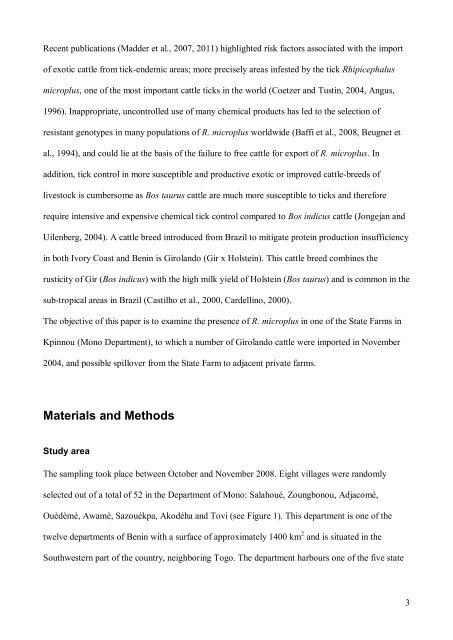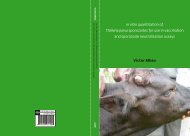Author template for journal articles - Itg
Author template for journal articles - Itg
Author template for journal articles - Itg
You also want an ePaper? Increase the reach of your titles
YUMPU automatically turns print PDFs into web optimized ePapers that Google loves.
Recent publications (Madder et al., 2007, 2011) highlighted risk factors associated with the importof exotic cattle from tick-endemic areas; more precisely areas infested by the tick Rhipicephalusmicroplus, one of the most important cattle ticks in the world (Coetzer and Tustin, 2004, Angus,1996). Inappropriate, uncontrolled use of many chemical products has led to the selection ofresistant genotypes in many populations of R. microplus worldwide (Baffi et al., 2008, Beugnet etal., 1994), and could lie at the basis of the failure to free cattle <strong>for</strong> export of R. microplus. Inaddition, tick control in more susceptible and productive exotic or improved cattle-breeds oflivestock is cumbersome as Bos taurus cattle are much more susceptible to ticks and there<strong>for</strong>erequire intensive and expensive chemical tick control compared to Bos indicus cattle (Jongejan andUilenberg, 2004). A cattle breed introduced from Brazil to mitigate protein production insufficiencyin both Ivory Coast and Benin is Girolando (Gir x Holstein). This cattle breed combines therusticity of Gir (Bos indicus) with the high milk yield of Holstein (Bos taurus) and is common in thesub-tropical areas in Brazil (Castilho et al., 2000, Cardellino, 2000).The objective of this paper is to examine the presence of R. microplus in one of the State Farms inKpinnou (Mono Department), to which a number of Girolando cattle were imported in November2004, and possible spillover from the State Farm to adjacent private farms.Materials and MethodsStudy areaThe sampling took place between October and November 2008. Eight villages were randomlyselected out of a total of 52 in the Department of Mono: Salahoué, Zoungbonou, Adjacomè,Ouèdèmè, Awamè, Sazouékpa, Akodéha and Tovi (see Figure 1). This department is one of thetwelve departments of Benin with a surface of approximately 1400 km 2 and is situated in theSouthwestern part of the country, neighboring Togo. The department harbours one of the five state3











